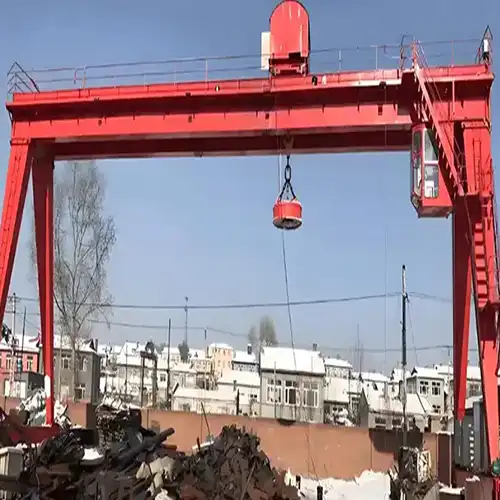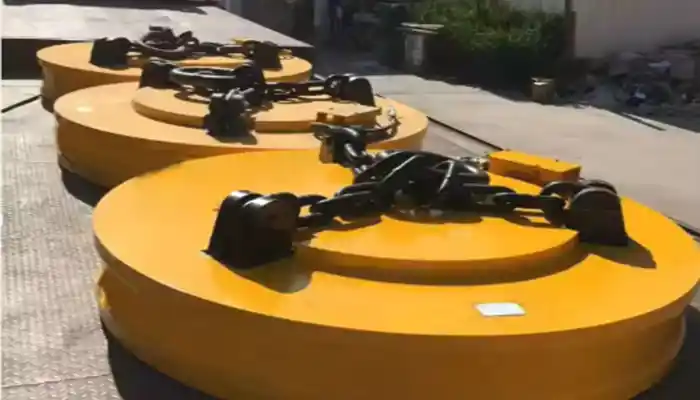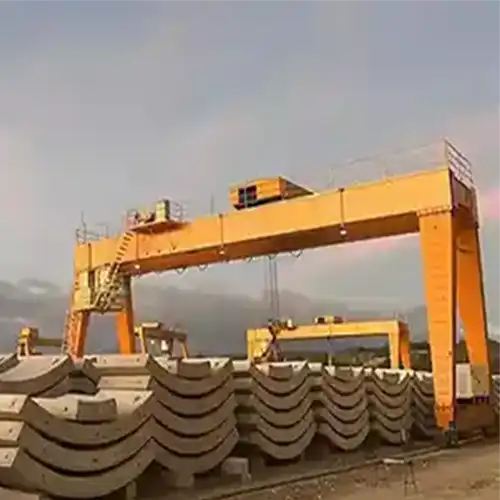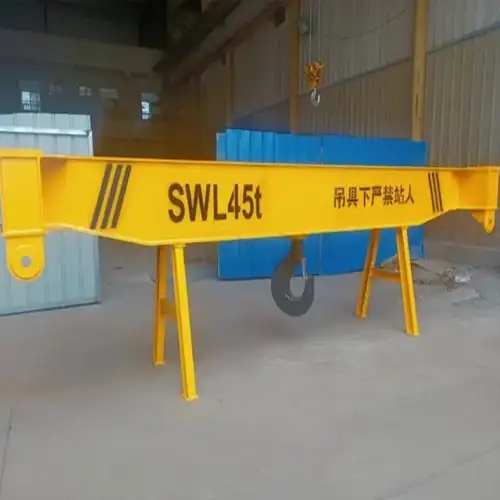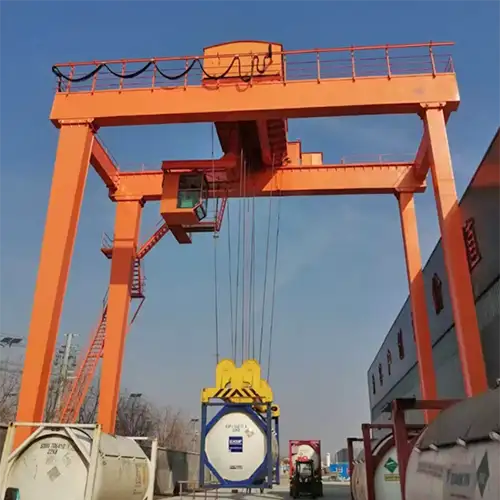
Preventing Coil Falls in Magnetic EOT Cranes: Magnet Overheating
Learn solutions to prevent wire rod coil falls caused by magnet overheating in electromagnetic EOT cranes through maintenance, cooling, & load management.
Introduction
Background and Context:
We recently received a question from a reader facing an issue with their crane operations. Here’s the situation:
"We are using WMI MAN EOT cranes with 5+5 T capacity for lifting wire rod coils in a steel mill. The cranes are equipped with two magnets, each capable of grabbing two coils weighing 1.2 tonnes each. However, sometimes the coils fall off the crane during transition. This happens due to the non-uniform surface of the wire rod coils or because the magnets overheat. We’re looking for ways to prevent this problem by making small modifications to our existing system."
This issue highlights two common challenges when using magnets to lift heavy loads:
- Non-uniform surfaces of the coils
- Overheating of the magnets during use
When either of these occurs, the magnetic grip weakens, which can cause coils to fall off the crane during movement.
Purpose of the Article:
This article is written to help the reader, and anyone facing a similar issue, with practical solutions to prevent coils from falling due to magnet overheating. The goal is to provide clear, simple steps that can be taken to solve this problem by making small changes to the existing system. The following suggestions will cover ways to improve magnet cooling, adjust operational practices, and consider small equipment upgrades—all designed to help reduce the chances of coil falls and improve the safety and reliability of crane operations.
Understanding Magnet Overheating
How Magnets Work in EOT Cranes:
Magnets play a crucial role in EOT cranes by providing the lifting power needed to handle heavy materials such as wire rod coils. These magnets generate a strong magnetic field that allows them to securely grip the coils, ensuring safe transport across the workshop or steel mill. The strength of the magnetic field is vital for maintaining control over the load, especially when lifting multiple coils at once.
Causes of Magnet Overheating:
Overheating can cause magnets to lose their efficiency, leading to problems like load slippage. Here are some common causes of magnet overheating:
- Excessive Load: When magnets are used to lift loads heavier than their rated capacity or when the load is unevenly distributed, the magnet works harder, generating excess heat. This heat buildup can lead to overheating.
- Continuous Operation: Operating the crane for extended periods without adequate breaks or downtime can cause the magnets to overheat. The lack of cooling time prevents the magnets from returning to a safe temperature, increasing the risk of performance degradation.
- Ambient Temperature: High temperatures in the workshop, such as those found in steel mills, can worsen the situation. In environments with extreme heat, magnets are more likely to overheat due to external factors beyond the crane’s control.
Impact of Overheating on Magnet Performance:
When magnets overheat, they lose part of their magnetic strength. This reduction in magnetic force makes it harder for the magnets to securely grip the wire rod coils. As a result, the load becomes unstable, increasing the risk of the coils slipping and falling off the crane during transition.
This loss of magnetic grip due to overheating can lead to safety hazards, damage to materials, and costly downtime. Therefore, it’s important to address overheating to maintain the reliability and safety of crane operations.
Consequences of Coil Falls
Safety Risks:
Coil falls can create serious safety hazards for workers near the crane.
- A falling coil, especially one weighing over a tonne, can cause severe injury or even death.
- Crane operators and other personnel working in the area are at risk of being struck by the falling load.
- It's crucial to ensure that safety measures are in place to protect workers from such accidents.
Operational Disruptions:
When coils fall, it leads to unplanned stoppages in crane operations.
- The crane must be halted to assess the situation, and the area must be cleared for safety.
- This downtime causes delays in the production process and disrupts the flow of work.
- Delays in production can affect delivery deadlines and customer satisfaction.
Equipment Damage:
Coil falls can cause damage to both the crane and the load.
- The crane may suffer structural damage, such as to the lifting components, hoists, or magnets.
- The coil itself may be damaged, leading to unusable materials.
- Repairing or replacing damaged equipment is costly and time-consuming.
Financial Implications:
The financial impact of coil falls goes beyond just the immediate damage.
- Repair costs for damaged equipment can add up quickly, leading to unplanned expenses.
- Production delays caused by coil falls reduce overall productivity, increasing operational costs.
- If an accident results in injuries or significant damage, it may lead to insurance claims and higher premiums.
- Overall, the financial consequences can be significant, making it essential to prevent coil falls whenever possible.
 electromagnetic crane for steel wire rod coil handling, customized eletromagnetic crane for your needs, with high temperature electromagnetic lifter
electromagnetic crane for steel wire rod coil handling, customized eletromagnetic crane for your needs, with high temperature electromagnetic lifter
Preventive Measures for Magnet Overheating
Regular Maintenance and Inspection:
- Temperature Monitoring: To prevent magnet overheating, it’s essential to regularly monitor their temperature during operation. Using infrared thermometers or temperature sensors can help detect any temperature rise before it becomes a problem. Monitoring ensures that you can take corrective action in time to avoid overheating.
- Routine Maintenance: Regular inspection and maintenance of the magnets are critical for preventing overheating. This includes checking for wear and tear, ensuring electrical systems are functioning properly, and verifying the integrity of the magnet’s components. A well-maintained magnet system is less likely to overheat, reducing the risk of coil falls.
Upgrading the Cooling System:
Active Cooling Systems: Installing active cooling systems can significantly reduce the temperature of magnets during operation. Options include:
- Fans: Installing fans around the magnets to help dissipate heat.
- Water-Cooled Jackets: For more intense cooling, water-cooled jackets can be fitted around the magnets to keep them at an optimal temperature. These systems can prevent overheating by providing continuous temperature control.
Improved Ventilation: Proper airflow around the crane and magnet system is essential for heat regulation. Enhancing ventilation in crane work areas allows for better air circulation, which helps in cooling down the magnets. A well-ventilated space can significantly lower the chances of magnet overheating.
Magnet Design Improvements:
- High-Temperature Resistant Magnets: Consider upgrading your magnets to those designed specifically for high-temperature environments. High-temperature resistant magnets are built to withstand higher operating temperatures without losing their magnetic strength. These magnets provide reliable performance even in extreme conditions, reducing the risk of overheating.
- Magnet Coatings: Another option is applying heat-resistant coatings to existing magnets. These coatings are designed to protect the magnets from heat damage and can prolong their lifespan. They act as a barrier, preventing excessive heat buildup from affecting the magnet's performance.
Optimizing Operational Practices:
- Load Management: Proper load management is critical to preventing overheating. Avoid lifting loads that exceed the magnet’s rated capacity, and ensure the coils are evenly distributed. Overloading or unevenly distributed loads can cause the magnet to work harder, generating more heat and increasing the risk of overheating.
- Operational Scheduling: Scheduling regular cooling breaks between lifts can help to maintain the magnet’s optimal temperature. Avoiding continuous operation without downtime gives the magnets time to cool down, preventing them from reaching unsafe temperatures.
Environmental Control:
- Temperature Regulation: In environments with extreme temperatures, such as steel mills, implementing climate control systems can help regulate the ambient temperature. Keeping the surrounding area cooler reduces the amount of heat absorbed by the magnets, decreasing the chances of overheating.
- Environmental Monitoring: Using environmental sensors to track factors like ambient temperature and humidity can help monitor conditions that affect magnet performance. By keeping an eye on these variables, you can adjust operational practices to prevent overheating caused by external environmental factors.
These preventive measures, when implemented correctly, can go a long way in minimizing the risk of magnet overheating and preventing coil falls in EOT cranes.
Technological Solutions and Innovations
Smart Sensors and Monitoring Systems:
- Real-Time Monitoring: Installing smart sensors on magnets allows for continuous temperature monitoring. These sensors can provide real-time data, enabling crane operators to keep track of magnet temperature at all times. If the temperature exceeds a predefined threshold, the sensors can send an alert, allowing immediate corrective actions to be taken. This proactive monitoring helps prevent overheating before it becomes a serious issue.
- Automated Shutdown Systems: Automated systems can be integrated into the crane's control system to pause operations when the magnet’s temperature becomes too high. These systems automatically stop lifting operations, giving the magnet a chance to cool down before it continues. This safety feature ensures that the crane doesn't continue operating under risky conditions, preventing further overheating and potential coil falls.
Advanced Magnet Technologies:
- Magnet Material Advancements: Ongoing research into new magnet materials is helping develop magnets that can handle higher temperatures without losing their magnetic force. These advancements in magnet technology provide more durable and efficient magnets that are better suited for high-temperature environments, such as steel mills. By switching to these advanced magnets, you can reduce the risk of overheating and improve the reliability of the crane system.
- Integrated Cooling Features: Modern magnet systems are being developed with built-in cooling features. These systems come equipped with integrated cooling elements, such as passive cooling jackets or active cooling circuits. These features help regulate the temperature of the magnet during operations, preventing overheating and ensuring a stable magnetic field throughout the lifting process. Upgrading to these advanced magnet systems can help keep your crane operation running smoothly and safely.
By adopting these technological solutions, crane operators can further improve the safety and efficiency of their lifting operations, reducing the risk of coil falls due to magnet overheating.
Conclusion
Preventing coil falls caused by magnet overheating requires several important actions:
- Regular Maintenance & Inspections: Regularly check magnets for wear and tear to ensure they’re functioning properly and not overheating.
- Upgrading Cooling Systems: Install cooling systems like fans or water-cooled jackets to regulate the magnet temperature, and improve ventilation in crane areas.
- Proper Load Management: Ensure coils are evenly distributed and within the rated capacity of the magnets to avoid overloading.
- High-Temperature Resistant Magnets & Coatings: Use magnets that are designed for high temperatures, or apply heat-resistant coatings to protect the magnets from overheating.
Implementing these actions can significantly reduce the risk of coils falling and improve crane safety.
With advancements in crane technologies, there are exciting opportunities to improve crane safety further. New developments in real-time monitoring systems, cooling solutions, and stronger magnet materials will make it easier to manage temperature-related issues and prevent overheating in the future. These innovations will make crane operations safer and more efficient.
Next Steps:
The solutions in this article are general suggestions and may help in many situations, but they’re not a one-size-fits-all fix. Every crane operation is different, so it’s important to analyze your specific situation more closely. You may need to inspect your equipment, review videos of crane operations, and collect more data to fully understand the cause of overheating and coil falls.
If you’re facing specific challenges with your crane, we recommend reaching out for further assistance. We can provide expert advice based on a more detailed evaluation of your equipment and operations. Please feel free to contact us if you need help in diagnosing and solving your problems.
